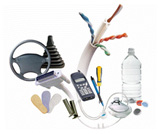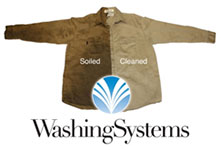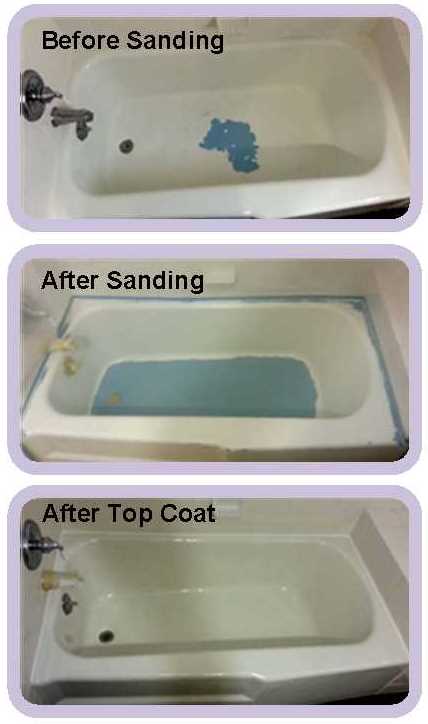Transitioning to Safer Chemicals:
A Toolkit for Employers and Workers
Success Stories
Many organizations have already realized worker health and safety benefits, increased productivity, and saved money by reducing the use of hazardous chemicals and implementing safer alternatives.
Designing a Safer Process for Chemical Manufacturing
DuPont Corporation
DuPont is a large chemical manufacturer that makes products for many industries — agriculture, marine, healthcare, energy, food and beverage, and mining, to name a few. Methyl isocyanate (MIC) is a highly toxic, irritating and flammable chemical that is commonly used to produce the carbamate pesticide methomyl; it is often manufactured in a separate production unit at facilities and stored in large pressure vessels. Following the 1984 deadly MIC release from the Union Carbide facility in Bhopal, India — where approximately 30 metric tons of toxic MIC escaped from a storage tank into the atmosphere in less than an hour killing thousands and injuring hundreds of thousands — DuPont implemented a new technology for producing methomyl at its plant in LaPorte, Texas. DuPont converted the less acutely toxic chemical methylformamide into MIC as a vapor-phase (rather than liquid) on an as-needed basis, which was immediately consumed in a subsequent reaction, leaving very little MIC in the system at one time and removing phosgene from the production process. DuPont's method reduced worker handling of several toxic chemicals; eliminated the need to transport, store, and transfer MIC and phosgene; and addressed lifetime cost issues.
Sources
Transitioning to Safer Chemical Alternatives in Wire and Cable Products
AlphaGary Corporation

AlphaGary specializes in the design and development of plastic compounds for a variety of applications. Internal company initiatives combined with external factors, including European and Massachusetts laws, influenced AlphaGary to collaborate with its supply chain partners and other stakeholders to investigate less toxic alternatives for lead compounds used as heat stabilizers in formulations for wire and cable products. Investments in research and internal capacities for product design, evaluation, and testing resulted in: the development of new lead-free product formulations that maintained quality and performance; reduced risk to workers handling lead-based materials; reduced medical monitoring and personal exposure monitoring for lead; improved product development capabilities; streamlined product certification processes; and enhanced the company's competitive global supply position.
Transitioning to Safer Chemical Alternatives in Laundry Detergents
Washing Systems, LLC

Washing Systems, LLC is a chemical supplier to the laundry industry in the U.S. and Canada. In 2005, the company's leadership made a critical decision to focus 100% of all research and development on new chemical technologies that exhibit safer, environmentally sustainable profiles. The initiative to develop a new "green" line of detergents became an immediate outgrowth of this decision and focused heavily on their use of nonylphenol ethoxylates (NPEs). The challenge of this initiative was set in seven critical project objectives:
- Detergents must be 100% free of NPEs
- Detergents must be used as one for one direct replacements for NPE detergents
- Detergents must have the same ounce for ounce cost to NPE detergents
- Detergents must exhibit the same “end-use” cost to the customer as NPE detergents
- Cleaning performance must be equal to or improved over NPE detergents
- Wash formulas must maintain the same “rapid rate” wash formulas as NPE detergents
- Detergents must be certified by the EPA's Design for Environment (DfE)
At the end of 2007, Washing Systems' R&D successfully met each of these objectives. In 2008, Washing Systems launched a new line of NPE-Free detergents into the commercial laundry market. Today, the success of this R&D project is evident to all Washing Systems customers, as all are 100% free of NPEs. This effort has reduced over 4.5 million lbs of NPEs/year from being discharged to the environment.
In addition to eliminating the use of NPEs in its products, Washing Systems has eliminated the use of butyl cellosolve and petroleum hydrocarbon based solvents in detergents, eliminated the use of phosphates and ethylenediaminetraacetic acid (EDTA) within the laundry builders, and reduced the petroleum hydrocarbon based solvents by 46% in other specialty products. The new formulations are not only less hazardous to workers and the environment, but also provide economic and efficiency benefits to Washing System's customers (i.e., reduced water and energy usage, increased wash productivity, lower chemical costs).
To identify alternatives, the company's scientists and engineers use CleanGredients®, a database of safer cleaning products ingredients that meet specific health and environmental criteria. The company also uses the GreenScreen™, a comparative chemical hazard assessment method, to evaluate and compare hazards of alternative chemicals. Washing Systems carries out extensive in-house performance testing as well as field trials in customers' facilities to ensure that the alternatives demonstrate superior levels of cleaning quality and operational performance compared to the chemistry it replaces.
Systematically Evaluating Hazardous Products and Transitioning to Safer Alternatives
Seattle City Light
Seattle City Light, one of the nation's largest municipally-owned electric utilities, has successfully developed and implemented a chemical use reduction policy and procedure for moving to safer products and processes. Under this policy, the utility is required to reduce the overall use of hazardous materials to the extent practical, to phase out the use of products that pose human health or environmental risks, and to increase the use of safer alternatives. To implement the policy, Seattle City Light reviews new products, as well as its existing chemical inventory, based on chemical acceptability criteria developed by the utility. The approval process uses this hazard evaluation to place the product into tiers and determine whether it should be classified as a preferred product. Only products that have made it through this approval process can be utilized by the utility in its operations. After the selection and implementation of preferred alternatives, Seattle City Light frequently conducts evaluations of product performance in particular applications, collaborating with workers to determine the impact of the alternatives on shop floor operations.

Through this ongoing process, the utility has been able to identify and transition to preferred products in a variety of applications. For example, when Seattle City Light reviewed its welding operations in steel shops, the utility identified a substitute for the use of thoriated tungsten electrodes, which expose workers to radiation. Seattle City Light utilized an alternatives assessment developed by the American Welding Society to select and replace these electrodes with ones containing lanthanum, a less toxic alternative that can be used in a wide range of applications. This move reduced worker exposures, as well as met the performance needs of the operation, without significantly increasing costs.
Transitioning to Safer Alternatives in Bathtub Stripping
Bathcrest of Seattle and the Seattle Bathtub Guy
The Washington State Department of Labor and Industries' Safety and Health Assessment and Research for Prevention (SHARP) Program worked with two small businesses exploring alternatives to methylene chloride-based paint strippers for bathtub refinishing.

Bathcrest of Seattle began investigating alternatives to methylene chloride-based paint strippers after Washington-OSHA assessed significant fines for their use of Klean-Strip Aircraft Remover during bathtub stripping. Bathcrest tested several paint strippers, including Turco 6776-LO (benzyl alcohol and formic acid), Ready-Strip Plus Safer Paint & Varnish Remover (dimethyl glutarate and N-methylpyrrolidone (NMP)) and Smart Strip (benzyl alcohol). Due to hazard, availability, and performance concerns, Bathcrest selected Smart Strip. Selecting and implementing this alternative is also supported by research that tested methylene chloride-free paint strippers and concluded that benzyl alcohol based products are the best choice. While using Smart Strip, Bathcrest successfully and competitively stripped over 1,000 tubs within a two year period.
The Seattle Bathtub Guy is a successful small bathtub refinishing business that uses scraping and sanding to prepare bathtubs instead of chemical paint strippers. In most cases, scraping and sanding only the damaged sections of the bathtub's finish is all that is necessary—the full removal of the top coat is needed only a small fraction of the time. The Seattle Bathtub Guy's experience has found scraping and sanding to be a faster, simpler, safer, and less expensive method for stripping bathtubs. By using this process, the business has been able to eliminate the odor and health risks associated with chemical paint strippers, prepare surfaces more quickly (1 to 1 ½ hours compared to chemical paint strippers that require time and multiple applications to work), and avoid the costs of complying with the methylene chloride standard (including medical surveillance).
Sources
Washington State Department of Labor & Industries. Successful Bathtub Stripping with Benzyl Alcohol as an Alternative to Methylene Chloride (MC). Retrieved from: https://lni.wa.gov/dA/16603c7542/MCHazAlertBenzylAlcoholAlternative.pdf *(PDF)
Institute for Research and Technical Assistance. Methylene Chloride Consumer Product Paint Strippers: Low-VOC, Low Toxicity Alternatives. Retrieved from: http://www.irta.us/reports/Methylene%20Chloride%20Consumer%20Product%20Paint%20Strippers%20REPORT%20ONLY.pdf *(PDF)
Washington State Department of Labor & Industries. Successful Bathtub Stripping Using Sanding as an Alternative to Methylene Chloride. Retrieved from: https://lni.wa.gov/dA/0490f4a504/BusinessProfileSanding.pdf
Has your business successfully implemented safer alternatives to hazardous chemicals, materials, products, or processes?
Contact us at saferchemicals@dol.gov to share your story.

